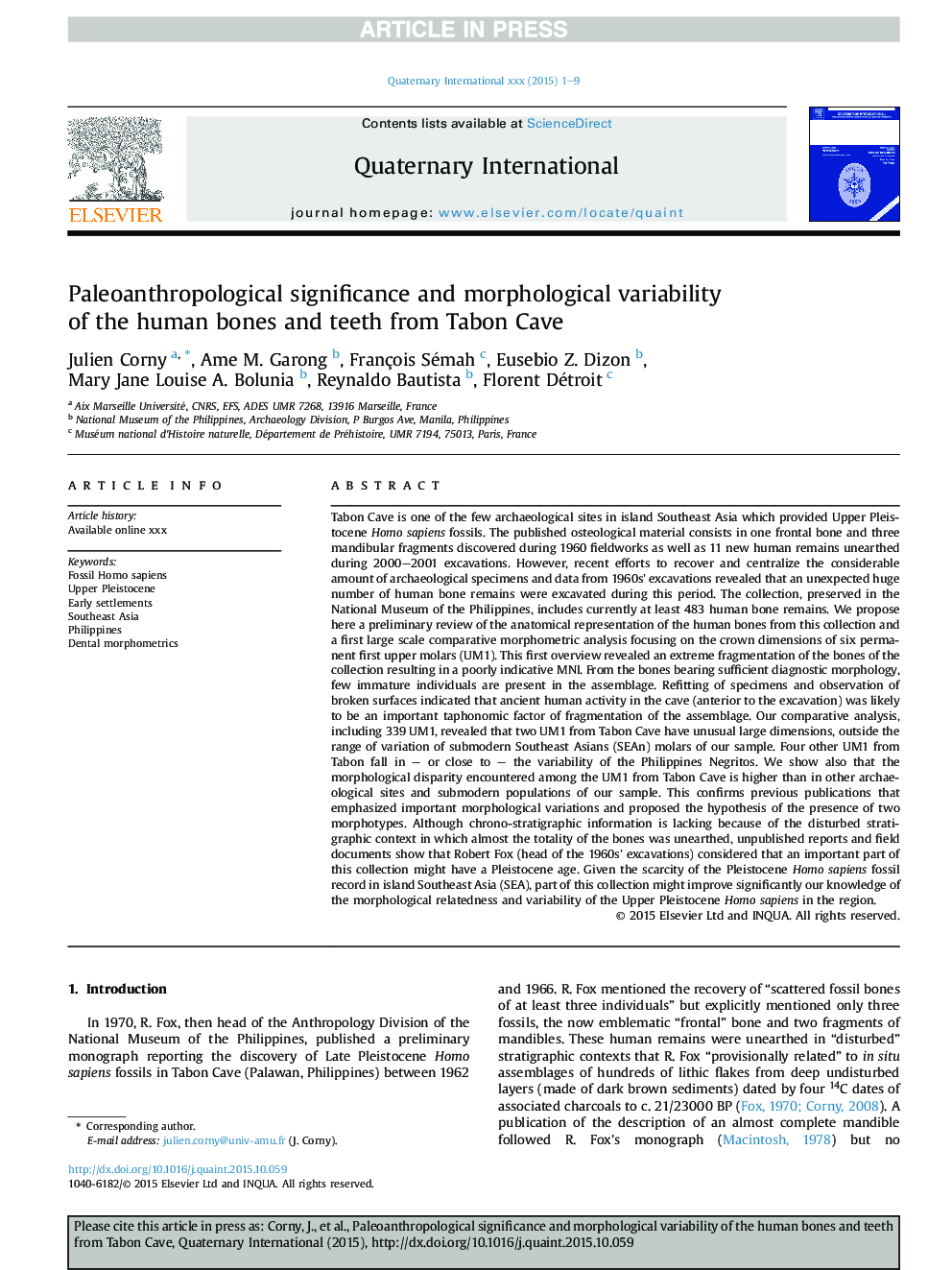| کد مقاله | کد نشریه | سال انتشار | مقاله انگلیسی | نسخه تمام متن |
|---|---|---|---|---|
| 5114073 | 1484091 | 2016 | 9 صفحه PDF | دانلود رایگان |
عنوان انگلیسی مقاله ISI
Paleoanthropological significance and morphological variability of the human bones and teeth from Tabon Cave
دانلود مقاله + سفارش ترجمه
دانلود مقاله ISI انگلیسی
رایگان برای ایرانیان
موضوعات مرتبط
مهندسی و علوم پایه
علوم زمین و سیارات
زمین شناسی
پیش نمایش صفحه اول مقاله

چکیده انگلیسی
Tabon Cave is one of the few archaeological sites in island Southeast Asia which provided Upper Pleistocene Homo sapiens fossils. The published osteological material consists in one frontal bone and three mandibular fragments discovered during 1960 fieldworks as well as 11 new human remains unearthed during 2000-2001 excavations. However, recent efforts to recover and centralize the considerable amount of archaeological specimens and data from 1960s' excavations revealed that an unexpected huge number of human bone remains were excavated during this period. The collection, preserved in the National Museum of the Philippines, includes currently at least 483 human bone remains. We propose here a preliminary review of the anatomical representation of the human bones from this collection and a first large scale comparative morphometric analysis focusing on the crown dimensions of six permanent first upper molars (UM1). This first overview revealed an extreme fragmentation of the bones of the collection resulting in a poorly indicative MNI. From the bones bearing sufficient diagnostic morphology, few immature individuals are present in the assemblage. Refitting of specimens and observation of broken surfaces indicated that ancient human activity in the cave (anterior to the excavation) was likely to be an important taphonomic factor of fragmentation of the assemblage. Our comparative analysis, including 339 UM1, revealed that two UM1 from Tabon Cave have unusual large dimensions, outside the range of variation of submodern Southeast Asians (SEAn) molars of our sample. Four other UM1 from Tabon fall in - or close to - the variability of the Philippines Negritos. We show also that the morphological disparity encountered among the UM1 from Tabon Cave is higher than in other archaeological sites and submodern populations of our sample. This confirms previous publications that emphasized important morphological variations and proposed the hypothesis of the presence of two morphotypes. Although chrono-stratigraphic information is lacking because of the disturbed stratigraphic context in which almost the totality of the bones was unearthed, unpublished reports and field documents show that Robert Fox (head of the 1960s' excavations) considered that an important part of this collection might have a Pleistocene age. Given the scarcity of the Pleistocene Homo sapiens fossil record in island Southeast Asia (SEA), part of this collection might improve significantly our knowledge of the morphological relatedness and variability of the Upper Pleistocene Homo sapiens in the region.
ناشر
Database: Elsevier - ScienceDirect (ساینس دایرکت)
Journal: Quaternary International - Volume 416, 19 September 2016, Pages 210-218
Journal: Quaternary International - Volume 416, 19 September 2016, Pages 210-218
نویسندگان
Julien Corny, Ame M. Garong, François Sémah, Eusebio Z. Dizon, Mary Jane Louise A. Bolunia, Reynaldo Bautista, Florent Détroit,